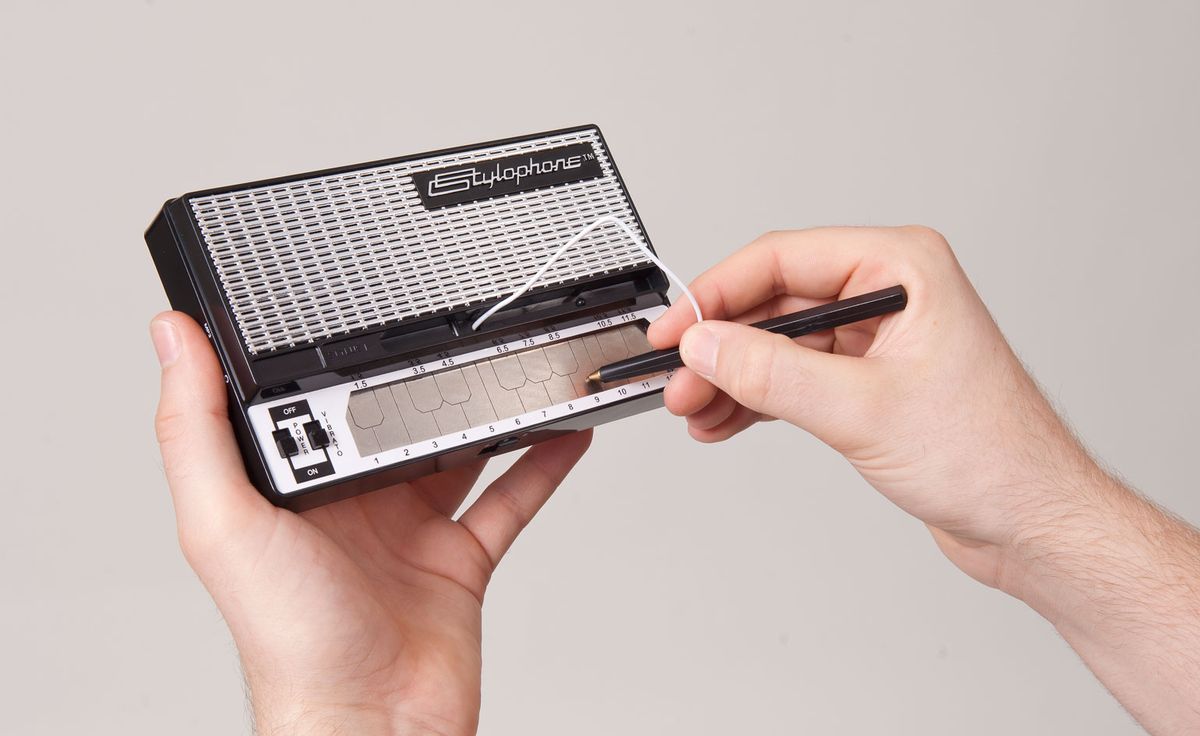Unlock your creativity with the Stylophone – the perfect tool for creating mesmerizing soundtracks and captivating background music. Explore its unique sound and intuitive design to compose music that leaves a lasting impression.
The Stylophone: A Brief Overview
The Stylophone, invented by Brian Jarvis in the late 1960s, is a small portable electronic keyboard instrument. It gained popularity for its distinctive sound and easy-to-use design. The original Stylophone featured a metal keyboard played by touching a stylus or pen-like device to the keys, creating a unique sound that blended elements of a synthesizer and an electric organ. In recent years, the Stylophone has undergone modern updates, offering enhanced features and expanded capabilities.

Features and Functionality of the Stylophone
The Stylophone may appear simplistic, but it boasts an array of features that contribute to its versatility as a music creation tool. Some of the notable features include:
- Sound Generation: The Stylophone produces sound through a combination of analog and digital circuitry. This fusion allows for a rich and warm tone, reminiscent of vintage electronic instruments.
- Multiple Octaves: The instrument typically spans three octaves, enabling users to access a wide range of musical notes and tones.
- Vibrato and Tone Controls: The Stylophone incorporates controls for vibrato and tone adjustments, offering musicians the ability to modulate the sound and create captivating effects.
- Line-Out and Headphone Jacks: The inclusion of these audio output options allows for easy integration with external audio equipment, such as mixers or amplifiers, or enables private practice with headphones.
- Built-in Speaker: The Stylophone also features a built-in speaker, making it a self-contained instrument suitable for on-the-go music creation.
Creating Soundtracks with the Stylophone
The Stylophone‘s unique sound and easy playability make it an excellent tool for creating soundtracks. Whether you’re a professional composer or an amateur musician, the Stylophone offers a distinctive sonic character that can add depth and personality to your compositions. Here are a few ways to utilize the Stylophone for soundtrack creation
- Melodic Hooks: The Stylophone’s distinct sound can serve as a melodic hook, instantly capturing the listener’s attention. By layering different melodic lines created on the Stylophone, you can build complex and engaging soundscapes.
- Atmospheric Textures: Experimenting with the instrument’s tone controls, vibrato, and effects can help you generate atmospheric textures that enhance the mood of your soundtrack. These ambient elements can create tension, evoke emotions, or set the stage for specific scenes.
- Rhythmic Patterns: The Stylophone’s responsive keyboard allows for the creation of rhythmic patterns. By layering different rhythmic motifs, you can build intricate percussion sections or add rhythmic complexity to your soundtracks.

Stylophone for Background Music: The Perfect Companion
Background music plays a crucial role in various settings, such as films, commercials, video games, and presentations. The Stylophone‘s versatility and ease of use make it an ideal companion for creating captivating background music. Here’s how the Stylophone can enhance your background music compositions:
- Ambient Sounds: The Stylophone’s warm and ethereal tones are perfect for creating ambient background sounds. Whether you need gentle pads, atmospheric textures, or soothing melodies, the Stylophone can help you craft the perfect sonic backdrop.
- Versatile Layering: The Stylophone’s multi-octave range and ability to play chords make it a versatile tool for layering different musical elements. You can add depth to your background music by combining multiple Stylophone tracks with other instruments or samples.
- Quick and Intuitive Composition: The simplicity of the Stylophone’s design allows for quick and intuitive composition. With its compact size, you can take it anywhere and compose on the go, making it convenient for generating ideas for background music.
- Portable and Compact: The Stylophone’s portable and compact nature makes it an excellent choice for musicians who need to create background music in various locations. Whether you’re on a film set, at a coffee shop, or in a studio, the Stylophone can be easily integrated into your creative process.
What are Stylophones used for?
Stylophones are used for various purposes in the world of music. They are popularly utilized for creating soundtracks, background music, and adding unique elements to musical compositions. The distinctive sound of the Stylophone can bring a captivating character to any musical piece.
Additionally, Stylophones have found their place in live performances, both as standalone instruments and as part of a larger setup. Their versatility allows musicians to explore different genres and experiment with a wide range of tones, making Stylophones a valuable tool for composers, musicians, and enthusiasts alike.
Is Stylophone hard to learn?
The Stylophone is known for its accessibility and user-friendly design, making it relatively easy to learn. Its simplistic layout, consisting of a keyboard and a stylus, allows beginners to quickly understand the basics of playing melodies and exploring different tones.

The responsive nature of the Stylophone’s keys makes it forgiving for those who are new to playing instruments. While mastery of any musical instrument requires practice and dedication, the Stylophone offers a gentle learning curve, making it an excellent choice for individuals looking to dive into the world of music creation.
How does a Stylophone make a sound?
The Stylophone utilizes a combination of analog and digital circuitry to produce its unique sound. When the stylus or pen-like device is touched to the metal keys of the instrument, an electrical circuit is completed, generating an audio signal.
This signal is then processed by the internal components, including oscillators, filters, and amplifiers, which shape and amplify the sound. The resulting audio is emitted through the built-in speaker or can be routed through external audio equipment for further manipulation or recording. The fusion of analog and digital elements contributes to the distinct and captivating sound of the Stylophone.
Is the Stylophone easy to play?
Yes, the Stylophone is designed to be easy to play, making it accessible for musicians of all skill levels. Its simple interface, consisting of a keyboard and stylus, allows for intuitive and immediate music creation. The keys are responsive and require minimal pressure to produce sound, making it effortless to play melodies, chords, and rhythmic patterns.
Additionally, the compact size and portability of the Stylophone enable musicians to play it anywhere, unleashing their creativity on the go. Whether you’re a beginner or an experienced musician, the Stylophone offers a user-friendly playing experience that encourages experimentation and musical exploration.
Making An Instrumental With Just Stylophones?
FAQs
Can the Stylophone be connected to other music equipment?
Yes, the Stylophone offers connectivity options such as line-out and headphone jacks, allowing you to connect it to external audio equipment like mixers, amplifiers, or recording devices.
Is the Stylophone suitable for beginners?
Absolutely! The Stylophone’s simplicity and intuitive design make it an excellent choice for beginners. It’s a great instrument to learn basic music concepts and develop a sense of melody and rhythm.
Can the Stylophone produce a wide range of sounds?
While the Stylophone has its distinct sound, it offers versatility within its sonic range. By utilizing different controls, effects, and playing techniques, you can create a variety of tones, from warm and mellow to bright and cutting.
Can the Stylophone be used in live performances?
Certainly! The Stylophone’s portability and built-in speaker make it suitable for live performances. Many musicians incorporate the Stylophone into their setups, using it to add unique elements to their performances or as a standalone instrument.
Is it possible to record and produce professional-quality music with the Stylophone?
Yes, with the right recording and production techniques, you can achieve professional-quality results using the Stylophone. It can be integrated into digital audio workstations (DAWs) and combined with other virtual instruments and effects to create polished and professional soundtracks or background music.
Conclusion
The Stylophone offers a remarkable and accessible way to create captivating soundtracks and background music. Its unique sound, portability, and versatility make it a valuable tool for musicians, composers, and hobbyists alike. Whether you’re looking to add melodic hooks, atmospheric textures, rhythmic patterns, or ambient sounds to your compositions, the Stylophone provides endless creative possibilities.
With its rich history and modern updates, the Stylophone continues to inspire and enable musicians to unlock their musical potential and bring their compositions to life. So, why not embark on a musical journey with the Stylophone and explore the vast sonic landscapes waiting to be discovered?



[…] is the backbone of any song, and the Stylophone offers a unique approach to melodic composition. The instrument’s metal keyboard allows for precise […]